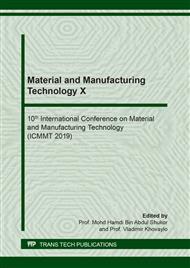p.162
p.171
p.176
p.181
p.189
p.194
p.199
p.204
p.209
Characterization of TAPE-Gelatin as a Potential Bioadhesive
Abstract:
Bioadhesives have much potential in the medical field as an alternative to sutures in internal surgery. They are easier to use and have better long-term results. Improvement of a new class of adhesives, tannic acid-polyethylene glycol (TAPE), was done by mixing it with gelatin, since it was found that TAPE alone could not be applied to certain internal applications like in inguinal hernia. It failed to close a fresh inguinal hernia sac. Characterization tests were done on the new material, TAPE-gelatin, which proved to have a tissue adhesion strength of 0.41 MPa which is 5 times greater than fibrin glue, good blood biocompatibility with blood clotting index of 97.46%, burst pressure strength that can withstand 1000 mL that is 10 times more than the volume in the peritoneal cavity, and cheaper, with a production cost of Php28.50, than commercially available bioadhesives, which can reach up to Php2,000 – Php30,000 per application. With its desirable properties, cheaper production cost, and large potential for scalability, TAPE-gelatin as a new candidate for medical adhesive was established.
Info:
Periodical:
Pages:
189-193
Citation:
Online since:
March 2020
Keywords:
Price:
Сopyright:
© 2020 Trans Tech Publications Ltd. All Rights Reserved
Share:
Citation:


